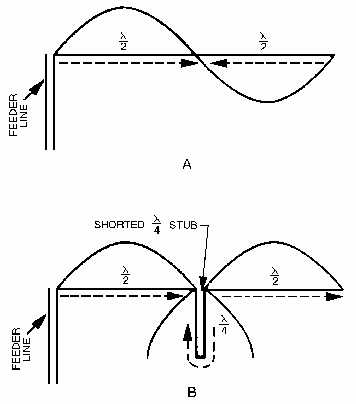4-27
radiation pattern shown in view B. The physical phase relationship caused by the 1/4-wavelength spacing
between the two elements, as well as the phase of the currents in the elements, has acted to change the
radiation pattern of the individual antennas.
Stub Phasing
In the case just discussed, the currents fed to the two antennas from the same transmitter were 90
degrees out of phase. Sections of transmission line, called STUBS, are frequently used for this purpose.
These stubs can be adjusted to produce any desired phase relationship between connected elements.
When two collinear half-wave elements are connected directly so their currents are in the same
phase, the effect is the same as that of a full-wave antenna, as shown in figure 4-22, view A. The current
in the first 1/2 wavelength is exactly 180 degrees out of phase with that in the second 1/2 wavelength.
This is the opposite of the desired condition. In the illustration, arrows are used to indicate the direction of
current flow in the antenna. (Using arrows is a convenient means of determining the phase on more
complicated arrays.)
Figure 4-22.—Phasing of connected elements.
When the two elements are connected by a shorted 1/4-wavelength stub, as shown in view B, current
travels down one side of the stub and up the other. It travels a distance of a 1/2 wavelength in the stub
itself. As a result, the current moves through 1/2 cycle of change. When the current reaches the second
element, it is in the desired phase. Since the current on one side of the stub is equal and opposite to the
current on the other side, the fields produced here cancel and no radiation is transmitted from the stub
itself.

